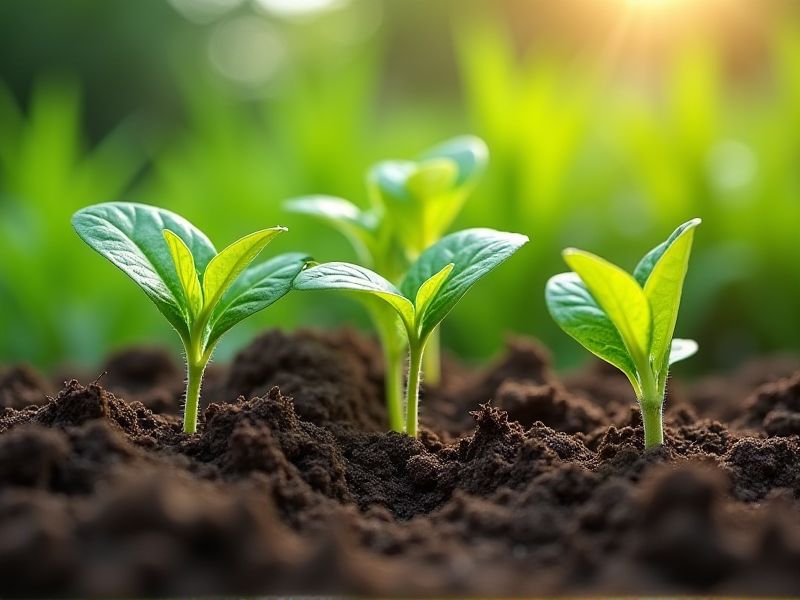
Fast-growing plants, such as vetiver grass, bamboo, and certain legumes, play a crucial role in soil stabilization by reducing erosion and enhancing soil structure. Vetiver grass, known for its deep root system, can significantly lower soil erosion on slopes and riverbanks. Bamboo, with its rapid growth and extensive root network, serves not only to stabilize soil but also to improve water absorption and promote biodiversity. Leguminous plants, like clover and alfalfa, contribute by fixing nitrogen in the soil, enriching it while reducing runoff. Incorporating these plants into your landscape can lead to healthier soil and more resilient ecosystems.
List of some Fast-growing plants that stabilize soil
- Willow (Salix spp.)
- Bamboo (Bambusoideae spp.)
- Silver Maple (Acer saccharinum)
- Alder (Alnus spp.)
- Switchgrass (Panicum virgatum)
- Vetiver (Chrysopogon zizanioides)
- Acacia (Acacia spp.)
- Poplar (Populus spp.)
- Creeping Juniper (Juniperus horizontalis)
- Reed Canary Grass (Phalaris arundinacea)
Important things about Fast-growing plants that stabilize soil
Rapid Growth Rate.
Fast-growing plants, such as ryegrass and comfrey, play a crucial role in stabilizing soil and preventing erosion. These species develop extensive root systems that bind the soil together, effectively reducing runoff and improving water retention. By covering bare ground quickly, they create a protective layer against harsh weather conditions, promoting healthier ecosystems. Incorporating these plants into your landscaping can enhance soil quality while fostering biodiversity in your garden.
Deep Root Systems.
Fast-growing plants with deep root systems, such as vetiver grass and certain tree species like willow and poplar, play a crucial role in soil stabilization. These plants anchor the soil with their extensive root networks, preventing erosion and maintaining the integrity of the land. By rapidly absorbing water and nutrients, they not only support their growth but also enhance soil health and fertility, benefiting surrounding ecosystems. Incorporating these plants into your landscaping or agricultural practices can effectively combat soil degradation while promoting biodiversity.
Erosion Control.
Fast-growing plants, such as vetiver grass, bamboo, and certain varieties of legumes, play a crucial role in erosion control by stabilizing soil through their extensive root systems. These plants not only enhance soil structure but also absorb water, reducing runoff and promoting groundwater recharge. Native ground covers, like clover and creeping thyme, further aid in preventing topsoil loss while fostering biodiversity. You can boost soil stability and create a sustainable ecosystem by incorporating these plants into your landscape design.
Habitat Creation.
Fast-growing plants play a crucial role in habitat creation by stabilizing soil and preventing erosion. Species such as bamboo, fescue, and vetiver grass establish extensive root systems that bind the soil, enhancing its structure and moisture retention. These plants not only improve soil stability but also promote biodiversity by providing essential habitats for various wildlife. When you incorporate these species into your landscaping or restoration project, you contribute significantly to ecological health and resilience.
Nutrient Cycling.
Fast-growing plants, such as ryegrass and clover, play a crucial role in nutrient cycling and soil stabilization. These plants quickly establish a dense root system that binds soil particles together, reducing erosion and promoting soil health. By taking up nutrients and organic matter from the soil, they enhance fertility and make these resources available for subsequent crops. Incorporating these fast-growing species into your land management practices not only improves soil structure but also fosters biodiversity and enhances ecosystem resilience.
Water Retention.
Fast-growing plants like vetiver grass and kudzu are essential for enhancing soil stability and reducing water retention issues. These plants have extensive root systems that anchor the soil, preventing erosion while facilitating water infiltration. By absorbing excess moisture, they help regulate the water table, ultimately contributing to healthier soil ecosystems. Incorporating these plants into landscaping or agricultural practices can significantly improve soil structure and minimize water runoff.
Biodiversity Enhancement.
Fast-growing plants, such as Vetiver grass and silver birch, play a crucial role in enhancing biodiversity and stabilizing soil. These species quickly establish root systems that bind soil particles, preventing erosion and promoting healthy ecosystems. By integrating these plants into your landscape, you can improve soil health, enhance water retention, and support local wildlife habitats. Moreover, their rapid growth contributes to carbon sequestration, making them integral in combating climate change while enriching your environment.
Carbon Sequestration.
Fast-growing plants play a crucial role in carbon sequestration by rapidly absorbing carbon dioxide from the atmosphere while enhancing soil stability. Species such as switchgrass and bamboo are particularly effective due to their deep root systems, which prevent erosion and improve soil structure. By implementing these plants in erosion-prone areas, you can significantly enhance soil health while contributing to climate change mitigation efforts. This dual benefit makes fast-growing plants an essential tool for sustainable land management practices.
Reduced Weed Competition.
Fast-growing plants, such as ryegrass and vetch, are highly effective for soil stabilization and reducing weed competition. These plants establish rapidly, creating a dense cover that inhibits the growth of unwanted weeds by outcompeting them for sunlight and nutrients. Their root systems enhance soil structure, preventing erosion and promoting water retention, which is crucial for maintaining soil health. Incorporating these plants into your landscape or agricultural practices can significantly improve soil stability while minimizing the need for chemical herbicides.
Aesthetic Landscaping.
Fast-growing plants play a crucial role in aesthetic landscaping by stabilizing soil and preventing erosion. Species such as bamboo, silver maple, and creeping thyme establish robust root systems that enhance soil structure while providing lush greenery. Utilizing these plants not only improves your garden's aesthetics but also promotes biodiversity, attracting beneficial insects and wildlife. Incorporating such plants into your landscape design can create visually appealing environments while safeguarding your soil health for the long term.
